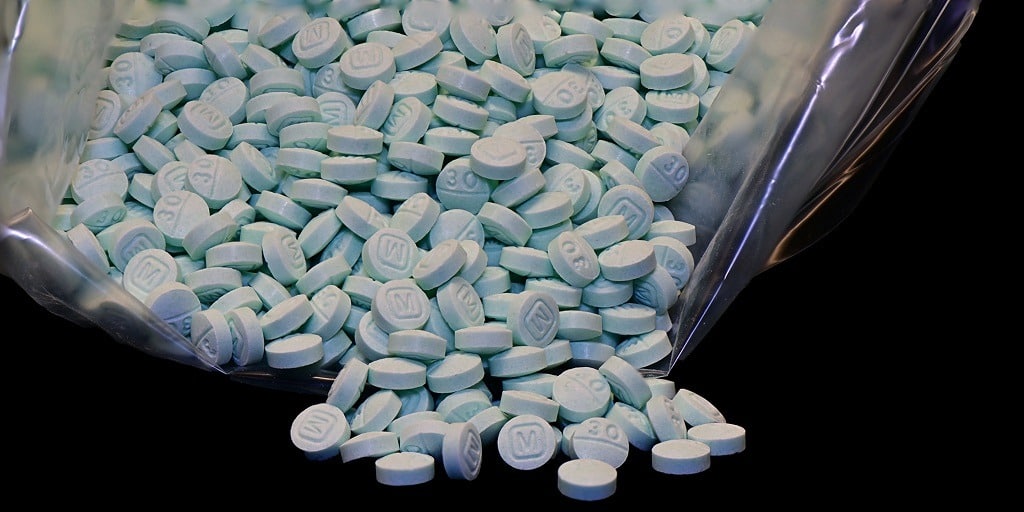Fentanyl is a potent and dangerous synthetic opioid that’s been implicated in the rising overdose deaths. With a potency 50 to 100 times that of morphine, fentanyl misuse can have severe consequences – especially when it’s mixed with other drugs.

There Is A Better Way To Live. It's Time To Get The Help You Deserve.
Statistics On Fentanyl Use, Misuse, And Addiction
While fentanyl is often prescribed for pain management, misuse of prescription fentanyl can occur. According to the Substance Abuse and Mental Health Services Administration (SAMHSA), in 2019, an estimated 1.1 million individuals aged 12 or older misused prescription opioids like fentanyl for the first time in the previous year.[2]
Long-term use of fentanyl carries the risk of physical dependence and addiction. The National Survey on Drug Use and Health (NSDUH) indicated that in 2019, an estimated 499,000 people aged 12 or older had a prescription opioid use disorder involving fentanyl or other synthetic opioids.[3]
According to the CDC, synthetic opioids like fentanyl are the main driver of overdose deaths. Nearly 88% of the 106,699 opioid-involved overdose deaths in 2021 involved synthetic opioids.[4]

Effects Of
Fentanyl Abuse
The short-term effects of fentanyl abuse include:
- Euphoria
- Drowsiness
- Confusion
- Small pupils
- Nausea and vomiting
- Constipation
- Slowed breathing
The long-term effects of fentanyl abuse may include:
- Chronic and severe constipation
- Breathing problems during sleep
- A suppressed immune system
- Heart attack and heart failure
- Hormonal and reproductive issues
- Anxiety, depression, and other mood disorders
- Dependence and withdrawal
- Addiction
- Increased risk of overdose
Can You Overdose on Fentanyl?
Illicitly produced fentanyl is one of the leading causes of fatal overdoses in the US. The risk of fentanyl overdose increases when the drug is mixed with other drugs – with or without the person’s knowledge – but can happen with prescription fentanyl, which is why it’s important to take fentanyl under medical supervision.
Signs and Symptoms of Fentanyl Overdose
A fentanyl overdose can be deadly. The signs and symptoms of fentanyl overdose include:
- Loss of consciousness
- Shallow, irregular, or stopped breathing
- Tiny pupils
- Limp body
- Blue, cold, or pale skin
- Choking or gurgling noises
What to do if you suspect someone is overdosing on fentanyl:
If you suspect someone is overdosing on fentanyl, call 911 immediately. Wait for emergency medical professionals and try to keep the person conscious. You can turn them on their side to prevent choking if they vomit. Administer naloxone if you have it. If they don’t start breathing normally within two or three minutes, administer another dose.
Dangers of Long-Term Fentanyl Use
Long-term fentanyl use poses significant risks to physical and mental health. It’s an extremely potent opioid, and misuse over extended periods can lead to serious consequences like:
- Tolerance: Abusing fentanyl over long periods may lead to tolerance, which is when you need a higher dose to achieve the same effects.
- Physical dependence: Long-term use of fentanyl can lead to physical dependence, which is when the body becomes accustomed to the presence of the drug. Abruptly stopping or reducing the dose can cause withdrawal symptoms.
- Addiction: Persistent use of fentanyl increases the risk of developing an addiction.
- Overdose: The risk of overdose significantly increases with frequent or prolonged abuse of fentanyl. Because of its potency, just a small increase in dosage can cause life-threatening toxicity (overdose).
- Cardiovascular issues: Fentanyl use can contribute to cardiovascular problems like low blood pressure and a slowed heart rate that affect heart health.
- Cognitive impairment: Chronic fentanyl abuse can cause cognitive impairment, including difficulties with memory, attention, and decision making.
- Increased disease risk: People who abuse fentanyl intravenously are at an increased risk of contracting infectious diseases like HIV and hepatitis.
Mixing Fentanyl with Other Drugs
Mixing fentanyl with other drugs, including prescription medications, can increase the risk of overdose and adverse effects. Fentanyl is potent, and mixing it with other substances can have unpredictable and dangerous consequences. Some of the risks of mixing fentanyl with other drugs include:
- Increased respiratory depression, particularly with other depressants like benzodiazepines or alcohol
- Dangerous levels of sedation and drowsiness
- Potentially fatal overdose
- Strain on the cardiovascular system, particularly with stimulant drugs like cocaine or methamphetamine
- Impaired cognitive function like confusion or memory loss
- Increased risk of life-threatening serotonin syndrome with drugs that affect serotonin levels, such as selective serotonin reuptake inhibitors (SSRIs)
- Changes in the perception of pain, which can lead to unintentional injury
Fentanyl Addiction and Abuse
The official term for a fentanyl addiction is an opioid use disorder (OUD), which is the compulsive use of a substance that leads to problems or distress. According to the Diagnostic and Statistical Manual of Mental Disorders, 5th Edition (DSM 5-TR), people with OUD experience the following patterns within a 12-month period:[6]
- Taking opioids for longer periods or in higher amounts than intended
- Spending a lot of time obtaining, using, or recovering from opioids
- Experiencing cravings to use opioids
- Trying to stop or reduce opioid use unsuccessfully
- Continued opioid use despite interpersonal problems
- Difficulties at home, work, or school
- Giving up activities or hobbies because of opioid use
- Engaging in reckless or dangerous behaviors under the influence of opioids
- Developing a tolerance for opioids
- Experiencing withdrawal when stopping or reducing opioid use
Is Fentanyl Addictive?
Fentanyl is highly addictive because of its potency. Like other opioids, it acts on the opioid receptors in the brain and body, providing pain relief and euphoria that may encourage misuse.
How Addictive is Fentanyl?
With a potency 50 to 100 times that of morphine, another powerful opioid, fentanyl is among the most addictive substances available.
Signs of Addiction to Fentanyl
The signs of addiction to fentanyl can vary but may include:
- Weight loss
- Poor concentration and focus
- Mood swings or agitation
- Problems with relationships
- Significant changes in sleep
- Social isolation
- Problems at work, home, or school
- Drug-seeking behaviors
- Financial strain
- Lying and secretive behavior
Fentanyl Addiction And
Mental Health
Fentanyl can have significant effects on mental health. Prolonged abuse c an lead to changes in brain chemistry and negative effects on mood, cognition, and overall mental wellbeing, as well as an increase in anxiety, depression, or other mental health disorders.


Cutting Agents Used For Fentanyl
Illicit fentanyl may be mixed with other drugs or cutting agents, including benzocaine, lidocaine, baby powder, caffeine, chloroquine, aspirin, or xylazine, leading to unpredictable and dangerous effects.
Fentanyl Addiction Treatment
Fentanyl addiction treatment usually includes a comprehensive and individualized treatment plan that addresses the physical, psychological, and social aspects of addiction. The cost and length of treatment can vary based on the severity of the addiction and the treatment setting.
Fentanyl Addiction Treatment Levels of Care
Fentanyl addiction treatment is highly personalized. Depending on your needs, the treatment options may include:
- Medical detox: Withdrawal from fentanyl can be intense. Medical detox with monitoring from a medical team is recommended to keep you safe and as comfortable as possible hile the drug clears your system. This also reduces the risk of relapse.
- Inpatient rehabilitation: Inpatient involves staying at a residential facility with 24/7 care, support, and supervision for people who need intensive care.
- Outpatient rehabilitation: Outpatient programs offers flexibility without compromising therapeutic support. You can live at home and attend scheduled therapy sessions that work with your schedule.
- Aftercare: Once rehab is complete, aftercare is available for ongoing counseling or support as you transition back to daily life.
Therapies Used in Fentanyl Addiction Treatment
Along with traditional therapies like talk therapy and group counseling, fentanyl addiction treatment may include medications approved by the Food and Drug Administration (FDA) like methadone, a long-acting opioid agonist that helps to control cravings, and buprenorphine, an opioid partial agonist that activates the opioid receptors in the brain to reduce dependency.
These medications are often combined with other therapies like:
- individual therapy
- One-on-one psychiatric care
- Group therapy
- Experiential therapy
- Family counseling
- Eye movement desensitization and reprocessing (EMDR)
- Surf therapy
- Somatic experience
- Nutritional counseling
Co-Occurring Disorders
According to the National institute on Drug Abuse, over 7.7 million Americans suffer from co-occurring substance abuse and mental disorders. Because they occur simultaneously, co-occurring disorders must be treated holistically.[5]
How to Find Fentanyl Addiction Treatment in Orange County
If you or a loved one is struggling with fentanyl addiction, help is available near you. The best place to start is by speaking to your insurance provider or primary care provider, but you can also search the Behavioral Health Services Locator tool from SAMHSA to find fentanyl rehab near me.
Once you find a few treatment centers, do your research to choose the right one. Make sure to read reviews and ask people within your network about their experiences to ensure the right fit.
Learn More About Our Programs
Fentanyl Detox And Withdrawal
Management
Fentanyl withdrawal occurs when you are physically dependent on the drug and reduce or discontinue its use. Though fentanyl withdrawal is not usually life threatening, it can be intense and uncomfortable.
Some of the symptoms of withdrawal may include:
- Flu-like symptoms
- Nausea and vomiting
- Diarrhea
- Abdominal cramps
- Joint pain
- Back pain
- Muscle aches
- Sweating
- Chills
- Restlessness
- Sleep problems
- Irritability
- Anxiety
- Depression
- Mood swings
- Heightened perception of pain
- Intense cravings
These symptoms can be severe enough to cause relapse to relieve them. Medical detox is recommended to provide support and medications that help to manage the symptoms during the withdrawal period.

Frequently Asked Questions
Where Is Fentanyl Made?
Most fentanyl on the illicit market is produced in Mexico using chemicals made in China. It may be mixed with other street drugs to improve profits, leading to overdoses.
Why Is Fentanyl So Dangerous?
Fentanyl is an extremely potent drug. Just a small dose can be enough to cause a fatal overdose. When fentanyl is mixed with other drugs, it’s impossible to detect, so people may not even realize they’re taking it.
How Long Does Fentanyl Stay in the System?
Fentanyl can show up on various drug tests for months after last use. Urine tests can detect fentanyl between 24 and 72 hours, while blood tests can detect it between five and 48 hours. Hair tests can detect fentanyl for up to three months.
Sources
[1] Fentanyl: One pill can kill. (n.d.). Dallas College. https://www.dallascollege.edu/resources/health-centers/health-promotion/pages/fentanyl.aspx
[2] SAMHSA, C. for B. H. S. and Q. (n.d.).Key substance use and mental health indicators in the United States:results from the 2019 National Survey on Drug Use and health. Key Substance Use and Mental Health Indicators in the United States: Results from the 2019 National Survey on Drug Use and Health. Retrieved from https://www.samhsa.gov/data/sites/default/files/reports/rpt29393/2019NSDUHFFRPDFWHTML/2019NSDUHFFR090120.htm on 2023, November 20.
[3] SAMHSA, C. for B. H. S. and Q. (n.d.).Key substance use and mental health indicators in the United States:results from the 2019 National Survey on Drug Use and health. Key Substance Use and Mental Health Indicators in the United States: Results from the 2019 National Survey on Drug Use and Health. Retrieved from https://www.samhsa.gov/data/sites/default/files/reports/rpt29393/2019NSDUHFFRPDFWHTML/2019NSDUHFFR090120.htm on 2023, November 20.
[4] Spencer, M. R., Miniño, A. M., U.S. DEPARTMENT OF HEALTH AND HUMAN SERVICES, Centers for Disease Control and Prevention, & National Center for Health Statistics. (2022). Drug overdose deaths in the United States, 2001–2021. In NCHS Data Brief (No. 457). https://www.cdc.gov/nchs/data/databriefs/db457.pdf
[5] U.S. Department of Health and Human Services. (2023, May 30).Comorbidity: Substance use and other mental disorders. National Institutes of Health. Retrieved from https://nida.nih.gov/research-topics/comorbidity/comorbidity-substance-use-other-mental-disorders-infographic on 2023, November 20.


